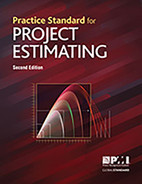TABLE OF CONTENTS
1.1 Purpose of this Practice Standard
1.2 Project Estimating Definitions
1.3 Scope of Project Estimating
1.4 Project Estimating and the Project Management Practice
1.5 Relationships among this Practice Standard and Other PMI Standards and Knowledge Areas
1.5.2 Practice Standard for Earned Value Management
1.5.3 Practice Standard for Work Breakdown Structures
1.5.4 Practice Standard for Scheduling
1.5.5 The Standard for Risk Management in Portfolios, Programs, and Projects
1.5.6 The Standard for Program Management
1.5.7 The Standard for Portfolio Management
1.5.8 The Standard for Organizational Project Management (OPM)
1.5.9 Navigating Complexity: A Practice Guide
1.5.11 The PMI Guide to Business Analysis (Includes: The Standard for Business Analysis)
2.3 Estimating Life Cycle Stages
2.5 Use of Metrics and Available Data
2.6.3 Portfolio Estimate Variances
2.7 Characteristics of an Estimate
2.8 Industry-Specific Practices
3.2 Prepare Project Estimating Approaches
4.2 Use of Quantitative Estimating Techniques
4.2.1 Analogous Estimating Techniques
4.2.2 Parametric Estimating Techniques
4.2.3 Bottom-Up Estimating Techniques
4.3 Use of Relative Estimating Techniques
4.3.1 Relative Estimating Technique Inputs
4.3.2 Relative Estimating Technique Outputs
4.3.3 Relative Estimating Technique Considerations
4.4 Use of Qualitative Estimating Techniques
4.4.1 Inputs to Qualitative Estimating
4.4.2 Outputs of Qualitative Estimating
4.4.3 Qualitative Estimating Considerations
4.5.2 Optimism and Pessimism in Estimates
4.5.3 Progressive Elaboration of Estimates
4.5.4 Cost–Schedule Interrelationship
4.5.7 Machine Learning and Artificial Intelligence in Estimating
5.2 Manage Estimates: A Living Plan Cycle
5.2.1 Inputs to the Manage Estimates Stage
5.2.2 Outputs of the Manage Estimates Stage
6.2 Assess the Estimating Process
6.2.1 Inputs to the Improve Estimating Process
6.2.2 Outputs of the Improve Estimating Process
6.3 Implement Changes and Share Lessons Learned
APPENDIX X1 THE PRACTICE STANDARD FOR PROJECT ESTIMATING – SECOND EDITION CHANGES
APPENDIX X3 CASE STUDY: BUILDING A CUSTOM BICYCLE
APPENDIX X4 ESTIMATING TOOLS AND TECHNIQUES
